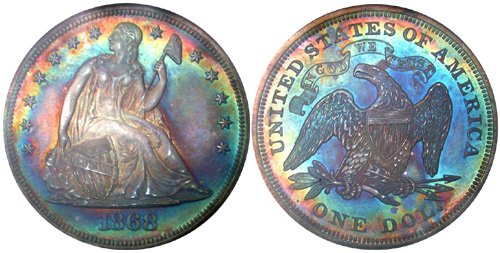Guide to U.S. Seated Liberty Dollars
Following a lengthy gap in production for the denomination, Seated Liberty Dollars were introduced in 1840 and struck until 1873. The reverse design was altered during the course of the series, creating two distinct subtypes. For most years, the coins were struck in limited quantities, heavily exported, and later melted, greatly diminishing the overall surviving population. A number of major rarities exist within the series including the 1870-S Seated Liberty Dollar, which ranks as one of the rarest silver dollars ever struck by the United States Mint.

In 1806, the production of silver dollars had been suspended within the United States in response to the greater need for small circulating coinage. The suspension would finally be lifted in 1831, however it would still take many years for the silver dollar to resume regular production.
The process of reintroducing the denomination began with the creation of the pattern or experimental Gobrecht Dollars, named after their designer Christian Gobrecht. Dated 1836, 1838, and 1839, these coins featured an early version of the obverse which would later appear on the Seated Liberty Dollar, paired with a reverse featuring a soaring bald eagle. Despite the fact that the denomination was not officially authorized, a small number of pieces were released directly into circulation. Their positive reception by the public led to the introduction of the new silver dollar series in the following year.
Obverse Design
The obverse design of the Seated Liberty Dollar was based on the concept of Britannia, who appeared on British coinage. Artist Thomas Sully made a number of sketches which Christian Gobrecht translated into designs for the Gobrecht Dollar and Robert Ball Hughes further modified for the Seated Liberty Dollar. The obverse features a depiction of the female figure of Liberty seated on a rock. In her left hand, she holds a pole with a Phrygian cap atop, while her right hand rests upon a shield inscribed “LIBERTY”. Thirteen stars surround the image and the date appears below.
Reverse Design
The reverse design was somewhat based on an earlier design by John Reich, which had been used on the smaller silver denominations during the early 19th century. A bald eagle appears with a shield at its breast, grasping an olive branch and arrows in its talons. The inscription “UNITED STATES OF AMERICA” appears above and the denomination expressed as “ONE DOL.” appears below. Starting in 1866, a scroll with the motto “IN GOD WE TRUST” was added above the eagle, creating a distinct subtype.
The mintage levels for the series were influenced by the price of silver as well as legislation passed by Congress. In the late 1840’s the discovery of gold in California caused the price of silver to increase relative to gold. Since silver coins were worth more as bullion than as currency, the coins stopped circulating and many were melted locally or exported abroad. In response to this situation, the Coinage Act of 1853 lowered the silver content of all denominations except for the silver dollar, which instead carried a new coining charge. The discovery of silver in Nevada changed the landscape once again and led to the passage of the Coinage Act of 1873. This legislation officially ended the production of standard silver dollars and authorized the Trade Dollar, which was primarily intended for export trade with Asia.

